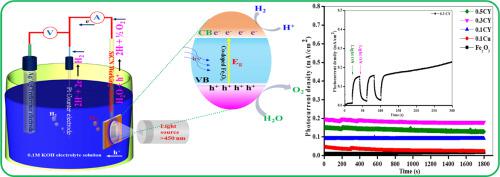当前位置:
X-MOL 学术
›
J. Electroanal. Chem.
›
论文详情
Our official English website, www.x-mol.net, welcomes your feedback! (Note: you will need to create a separate account there.)
Cu2+ and Y3+ co-doped effect on morphology, structural, optical and photoelectrochemical properties of Fe2O3 photoanode
Journal of Electroanalytical Chemistry ( IF 4.5 ) Pub Date : 2020-12-01 , DOI: 10.1016/j.jelechem.2020.114692 I. Neelakanta Reddy , Ch. Venkata Reddy , Migyung Cho , Dongseob Kim , Jaesool Shim
Journal of Electroanalytical Chemistry ( IF 4.5 ) Pub Date : 2020-12-01 , DOI: 10.1016/j.jelechem.2020.114692 I. Neelakanta Reddy , Ch. Venkata Reddy , Migyung Cho , Dongseob Kim , Jaesool Shim

|
Abstract Cu and Y co-doped hematite (α-Fe2O3) nanostructured photoanodes with excellent optical properties were synthesized for photoelectrochemical water splitting (PWS) applications. The effects of the dopants on the crystal structure, morphology, and optical and chemical properties of the Fe2O3 photoanodes were investigated. Structural and chemical analyses confirmed the substitution of Cu and Y ions into the Fe2O3 nanostructures. With an increase in the Y dopant concentration, the bandgap of the photoanodes decreased from ~1.85 to ~1.35 eV. The dopants acted as charge contributors and enhanced the electron-hole densities of the photoanodes. The co-doped Fe2O3 photoanodes showed higher photocurrents and hence higher incident light absorption capacities than did the undoped and Cu-doped samples. The α-Fe2O3 photoelectrode co-doped with 0.3 mol% Y and 0.1% Cu showed the highest photocurrent density of ~0.44 mA/cm2, which is ~41 times of that of the undoped Fe2O3 (0.01 mA/cm2) photoanode and ~ 7 times of that of the 0.1 mol% Cu-doped α-Fe2O3 photoanode. Furthermore, the Cu-doped photoanode showed a very low photocurrent density of 0.06 mA/cm2, which is only ~6 times of that of the undoped α-Fe2O3 photoanode. The high photocurrents of the co-doped photoanodes can be attributed to their high electron donor densities and low electron-hole recombination rates.
中文翻译:

Cu2+和Y3+共掺杂对Fe2O3光阳极形态、结构、光学和光电化学性能的影响
摘要 合成了具有优异光学性能的 Cu 和 Y 共掺杂赤铁矿 (α-Fe2O3) 纳米结构光阳极,用于光电化学水分解 (PWS) 应用。研究了掺杂剂对 Fe2O3 光阳极的晶体结构、形貌、光学和化学性质的影响。结构和化学分析证实了 Cu 和 Y 离子被 Fe2O3 纳米结构取代。随着 Y 掺杂剂浓度的增加,光阳极的带隙从~1.85 eV 降低到~1.35 eV。掺杂剂充当电荷贡献者并提高光阳极的电子空穴密度。与未掺杂和掺杂铜的样品相比,共掺杂的 Fe2O3 光阳极显示出更高的光电流,因此具有更高的入射光吸收能力。α-Fe2O3 光电极与 0. 3 mol% Y 和 0.1% Cu 显示出最高的光电流密度 ~0.44 mA/cm2,是未掺杂 Fe2O3 (0.01 mA/cm2) 光阳极的 ~41 倍和 0.1 mol% Cu 的 ~7 倍-掺杂的 α-Fe2O3 光阳极。此外,Cu 掺杂的光阳极表现出非常低的光电流密度,仅为 0.06 mA/cm2,仅为未掺杂的 α-Fe2O3 光阳极的约 6 倍。共掺杂光阳极的高光电流可归因于它们的高电子供体密度和低电子-空穴复合率。这仅是未掺杂的 α-Fe2O3 光阳极的约 6 倍。共掺杂光阳极的高光电流可归因于它们的高电子供体密度和低电子-空穴复合率。这仅是未掺杂的 α-Fe2O3 光阳极的约 6 倍。共掺杂光阳极的高光电流可归因于它们的高电子供体密度和低电子-空穴复合率。
更新日期:2020-12-01
中文翻译:

Cu2+和Y3+共掺杂对Fe2O3光阳极形态、结构、光学和光电化学性能的影响
摘要 合成了具有优异光学性能的 Cu 和 Y 共掺杂赤铁矿 (α-Fe2O3) 纳米结构光阳极,用于光电化学水分解 (PWS) 应用。研究了掺杂剂对 Fe2O3 光阳极的晶体结构、形貌、光学和化学性质的影响。结构和化学分析证实了 Cu 和 Y 离子被 Fe2O3 纳米结构取代。随着 Y 掺杂剂浓度的增加,光阳极的带隙从~1.85 eV 降低到~1.35 eV。掺杂剂充当电荷贡献者并提高光阳极的电子空穴密度。与未掺杂和掺杂铜的样品相比,共掺杂的 Fe2O3 光阳极显示出更高的光电流,因此具有更高的入射光吸收能力。α-Fe2O3 光电极与 0. 3 mol% Y 和 0.1% Cu 显示出最高的光电流密度 ~0.44 mA/cm2,是未掺杂 Fe2O3 (0.01 mA/cm2) 光阳极的 ~41 倍和 0.1 mol% Cu 的 ~7 倍-掺杂的 α-Fe2O3 光阳极。此外,Cu 掺杂的光阳极表现出非常低的光电流密度,仅为 0.06 mA/cm2,仅为未掺杂的 α-Fe2O3 光阳极的约 6 倍。共掺杂光阳极的高光电流可归因于它们的高电子供体密度和低电子-空穴复合率。这仅是未掺杂的 α-Fe2O3 光阳极的约 6 倍。共掺杂光阳极的高光电流可归因于它们的高电子供体密度和低电子-空穴复合率。这仅是未掺杂的 α-Fe2O3 光阳极的约 6 倍。共掺杂光阳极的高光电流可归因于它们的高电子供体密度和低电子-空穴复合率。



























 京公网安备 11010802027423号
京公网安备 11010802027423号